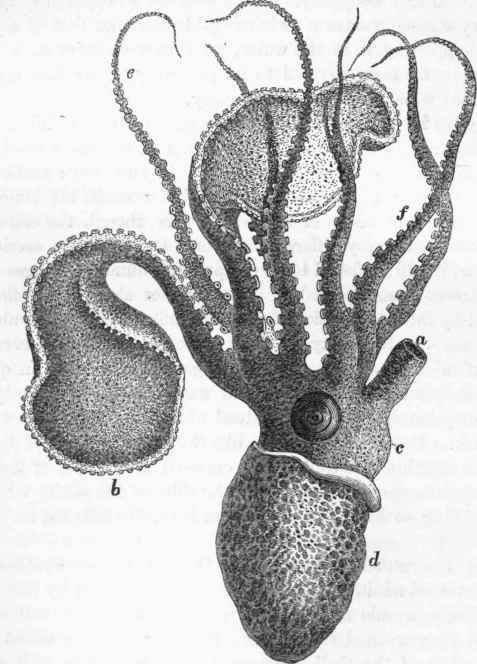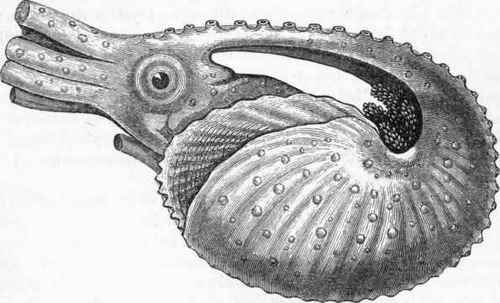Cephalopoda (Cuvier). Part 5
Description
This section is from the book "General Outline Of The Organization Of The Animal Kingdom, And Manual Of Comparative Anatomy", by Thomas Rymer Jones. Also available from Amazon: A General Outline of the Animal Kingdom and Manual of Comparative Anatomy.
Cephalopoda (Cuvier). Part 5

Fig. 285. Animal of the Argonaut out of its shell: a, the siphon; b, the so-called vela; c, the head; d, the body; e,f, locomotive tentacula. (After Poli).
(1531). M. Sander Rang, who, during a residence at Algiers, had ample opportunity of studying the living Argonaut, ascertained that in the figure copied from Poli, which we have given in a preceding page, the animal is placed in its shell in a reversed position, and that, when alive, the creature is always found with its veliferous arms turned towards the spire of its shell, instead of in the opposite direction, as represented in the drawing referred to. Moreover, the vela, instead of forming sails, are invariably tightly spread out over the external surface of the shell (fig. 286), which they cover and entirely conceal from view. With its veliferous arms thus firmly embracing its abode, the Argonaut has two modes of progression. It can certainly raise itself from the bottom, and sport about at the surface of the water; but this is simply effected by the ordinary means used by Calamaries and Cephalopods in general, namely by admitting the sea-water into its body and then ejecting it in forcible streams from its funnel, so as to produce a retrograde motion, which is sometimes very rapid. Its usual movements are, however, confined to crawling at the bottom with its head downwards; and in this way it creeps, carrying its shell upon its back.
(1532). The reader will obtain a better idea of the real appearance of the Argonaut in its shell by inspecting the annexed copy of M. Hang's figure than from any verbal description, and we borrow that gentleman's own account of its general appearance *. The membranous portions of the expanded arms, dilated beyond anything we could have pictured to ourselves while knowing the animal merely by specimens preserved in spirits of wine, are spread over the two lateral surfaces of the shell in such a manner as to cover it completely from the base of the hard edge to the anterior extremity of the edge of the opening, and consequently the keel. The application of these membranes is direct, and without any puckering or irregularity whatever, - the lower part of the two large arms being completely stretched, so as to form a kind of bridge over the cavity left between the back of the mollusk and the retreating portion of the spire. When the mollusk contracts itself, it frequently draws in more or less completely its large arms and their membranes, so as partially to uncover the shell in front, as is represented in the figure (fig. 286).

Fig. 286. Argonaut. (After M. Sander Rang).
* For more ample details upon this subject, the reader is referred to an excellent translation of M. Bang's paper contained in Mr. Charlesworth's Magazine of Natural History, new series, vol. iii.
(1533). There is little doubt that the vela of the Argonaut, which thus envelope its abode, are the organs employed in constructing the brittle fabrics, and the agents whereby fracture and wounds in the shell are repaired and filled up.
(1534). The positive experiments of Madame Power* leave no doubt upon the subject; for not only did that lady, by rearing young Argonauts from the egg, watch the first appearance and earliest growth of the shell, but, by breaking the testaceous covering of adult specimens, she found that they could readily repair the damage inflicted. Being desirous of observing the manner in which this operation was accomplished, the lady to whom science is indebted for these interesting researches examined an individual on the day after its shell had been intentionally broken, and found that the aperture was already covered by a thin glutinous lamella, which, although as yet as delicate as a cobweb, united the margins of the fracture. The next day the lamella had become thickened to a certain degree and more opake; till at length, at the end of ten or twelve days, the new piece had become quite calcareous. Madame Power is likewise certain that, while in the act of mending the fractures, the Argonaut applied its vela to the exterior of the shell, and wrinkled them upon it; whence they may naturally be regarded as being the source from which the glutinous secretion that finally became hardened into shell proceeded.
(1535). In order to understand the manner in which the remarkably-constructed camerated shells, such as those of Nautilus, are produced, it is not necessary to imagine any deviation from the simple mode of procedure adopted in all the cases we have as yet considered. The continual elongation of the spiral cone is, as is evident from the lines of growth visible upon its outer surface, effected by the addition of successive layers to the margin of the aperture of the last-formed chamber, wherein the animal resides; and as the production of the calcareous secretion whereby the shell is enlarged is most rapidly effected upon that side of the body where the funnel (fig. 284, i) is situated, the gradually-expanding shell naturally revolves around an excentric axis. While the growth of the shell continues, the animal is constantly advancing forwards, and thus leaves the first-formed portions of the shell unoccupied. At intervals, as the Nautilus thus removes itself further and further from the bottom of its abode, that portion of its mantle which covers the general surface of its visceral sac (fig. 284, a) secretes floors of shelly substance behind it; and thus the septa (s s) are formed, whereby the shell is separated into chambers, every chamber having in turn been occupied by the body of the Nautilus. The gradual prolongation of the fleshy siphon (h) is easily understood, because it naturally increases in length with the growth of the animal: but how the two muscles (fig. 284, g), that fix the body to the shell, progressively advance their points of attachment as the shell enlarges, is not so readily explained; neither are we prepared to account satisfactorily for the accomplishment of this part of the process.
Continue to:


